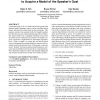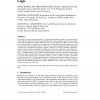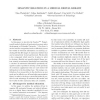988 search results - page 18 / 198 » SenseNet: A Knowledge Representation Model for Computational... |
COSIT
2007
Springer
14 years 1 months ago
2007
Springer
Higher level semantics are considered useful in the geospatial domain, yet there is no general consensus on the form these semantics should take. Indeed, knowledge representation p...
AAAI
2007
13 years 10 months ago
2007
bstract or nonliving entities act or are described as living. And living things gain extra benefits such as animals talking. For this reason, the standard scripts are modified to a...
KCAP
2005
ACM
14 years 1 months ago
2005
ACM
An ultimate goal of AI is to build end-to-end systems that interpret natural language, reason over the resulting logical forms, and perform actions based on that reasoning. This r...
LOGCOM
2000
13 years 7 months ago
2000
We introduce the concept of reflection principle as a knowledge representation paradigm in a computational logic setting. Reflection principles are expressed as certain kinds of l...
ADL
1998
Springer
13 years 12 months ago
1998
Springer
ct In this paper, we describe the VesaliusTM Project, a multi-modal collection of anatomical resourcesunder development at Columbia University. 1 Our focus is on the need for navig...



